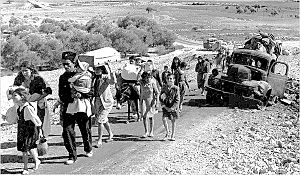Nakba facts for kids
The 1948 Palestinian exodus, also known as the Nakba (which means "disaster" or "catastrophe" in Arabic), was a major event in history. It happened during the 1948 Palestine war. During this time, over 700,000 Palestinian Arabs — about half of the Arab people living in Palestine before the war — had to leave their homes or were forced out.
Between 400 and 600 Palestinian villages were destroyed or emptied during the war. Many towns in Palestine also became empty. The term "Nakba" also refers to the entire difficult period of the war itself, from December 1947 to January 1949.
The exact number of people who became refugees is still debated. Many of them settled in refugee camps in nearby countries. About 80% of the Arab people living in the area that became Israel had to leave their homes. Around 250,000 to 300,000 Palestinians left or were forced out before Israel became an independent country in May 1948. This was one reason why Arab countries joined the war, starting the 1948 Arab–Israeli War.
What happens to these refugees, and if they can return to their homes or get help, is a big part of the ongoing Israeli–Palestinian conflict. Palestinians remember these events every year on May 15th, which is called Nakba Day.
Contents
What Happened During the Nakba?
The Nakba was a time when many people had to leave their homes. This happened during the 1948 war in Palestine. People left for different reasons. Some fled because of the fighting and danger. Others were forced to leave by soldiers.
Many villages and towns became empty. People had to leave behind their homes, farms, and belongings. They became refugees, meaning they had to find new places to live, often in temporary camps.
Why Did People Leave Their Homes?
People left their homes for several reasons during the 1948 war. The main reasons included:
- Fear of War: As fighting spread, many people were scared for their safety and the safety of their families. They left to escape the violence.
- Direct Expulsion: In some areas, people were directly forced out of their homes by military groups.
- Destruction of Villages: Many villages were destroyed during the conflict, making it impossible for people to stay.
These events led to a large number of people becoming refugees, seeking safety in neighboring countries or other parts of Palestine.
Remembering the Nakba: Nakba Day
Palestinians around the world remember the events of 1948 every year. This day is called Nakba Day, and it is observed on May 15th. It is a day for Palestinians to remember what happened to their families and communities. It is also a day to think about the future and the hopes of the refugees.
Related Pages
Images for kids
See also
 In Spanish: Nakba para niños
In Spanish: Nakba para niños



